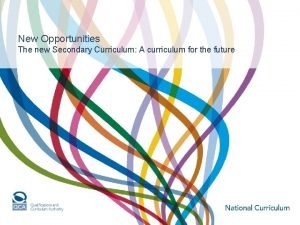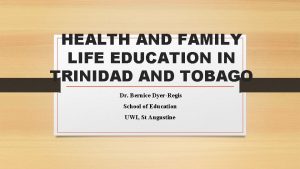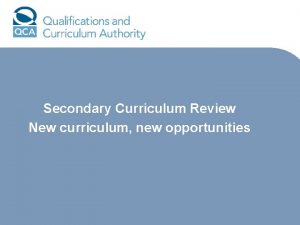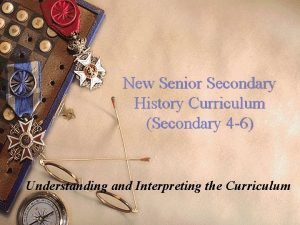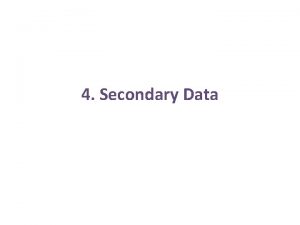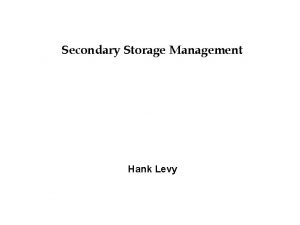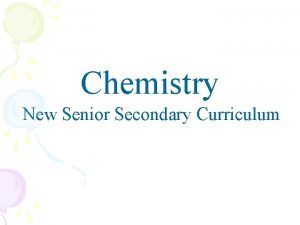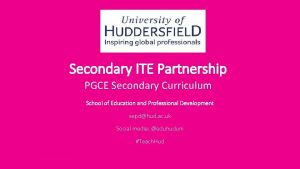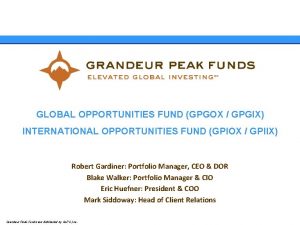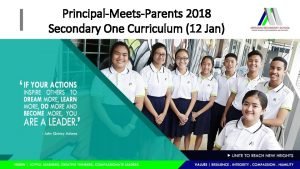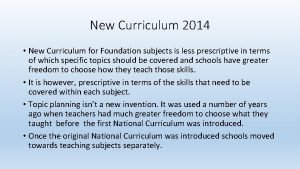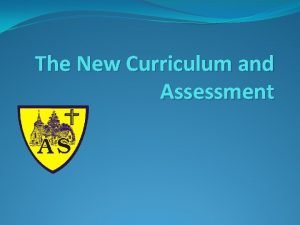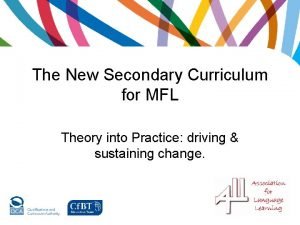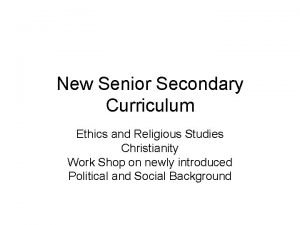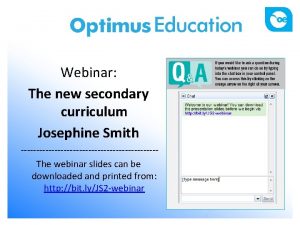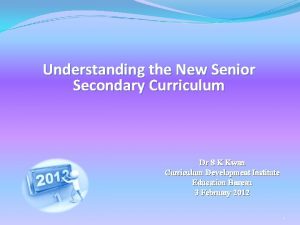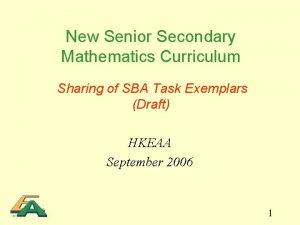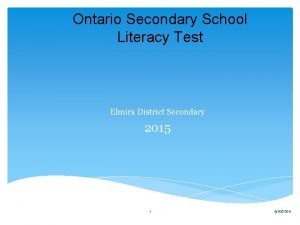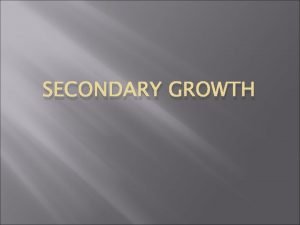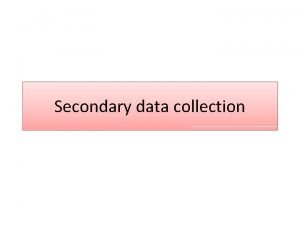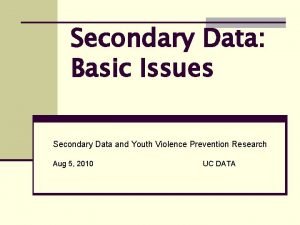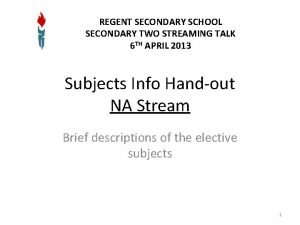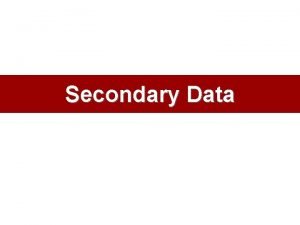New Opportunities The new Secondary Curriculum A curriculum



























- Slides: 27

New Opportunities The new Secondary Curriculum: A curriculum for the future

Develop a modern, world-class curriculum that will inspire and challenge all learners and prepare them for the future

Three questions driving curriculum design, development and implementation • WHAT are we trying to achieve? • HOW do we organise learning? • HOW well are we achieving our aims?

Why change?

Forces for change in society • Changes in society and the nature of work. • The impact of technology. • New understandings about the nature of learning. • Increased global dimension to life, learning and work • The public policy agenda - personalisation, ECM, sustainability, social cohesion, enterprise.

Some curriculum concerns… HMI Curriculum Matters 1985: "There is so much knowledge that is potentially useful or of intrinsic interest that syllabuses are often over laden with factual content built up by unregulated accumulation or tradition. In view of this… schools need to be highly selective when deciding what is taught. " QCA Monitoring 2005: "There is still a perception that the curriculum is overloaded. . . delegates continued to regard the curriculum as too full. In practice many find it difficult to incorporate newer ideas, including citizenship. The constraining factors include content overload, staffing problems and the perceived narrowness of the standards agenda. . . "

Headteachers say that a curriculum fit for the future should increase the focus on… • • competencies and skills personal development - as the cornerstone of successful learning flexibility and local ownership – more freedom to innovate. using knowledge actively. . as a cornerstone for creativity and knowledge creation through ‘communities of learning’. • cross curriculum themes such enterprise and employability, global dimension, and media literacy which are directly linked to wider aims. • a range of learning approaches e. g specialist teaching, crossdisciplinary problem based learning, independent study and coaching. • more attention to Af. L - minimise the negative consequences of the WYTIWYG.

What did employers say? • • • The basic skills are essential… but we also need young employees who: can take responsibility and show initiative have good interpersonal skills. . can work in teams are flexible and adaptable have ability to solve problems and generate new ideas have a good mix of qualifications, practical skills and personal qualities The education system should do more to market the benefits of learning to young people and develop a genuine customer service ethos.

What do young people think? • enjoy active lessons where they get involved – a wider repertoire of approaches We like to create, make, do, find out. We dislike “endless writing”. There’s “not enough use of technology” • think teachers who make sure they understand give useful feedback and praise make a difference. “We need to know what a good one looks like. ” • welcome a challenge and not too much repetition. “Definitely not too easy but not too hard” • recognise the importance of respect. They value an orderly, attractive school environment and the chance to work and socialise with friends. “We don’t like “bad attitudes” in teachers or other pupils, dislike sarcasm and shouting, want more consistency across classes” • want more choice, more practical life skills, more relevance and coherence.

Task 1: What are we trying to achieve? What will success look like? In your groups describe the characteristics of a successful learner and confident individual.

Futures agenda Changes in society Impact of technology New understanding about learning Globalisation Public policy Current concerns More space for personalisation – challenge and support – improved standards Less prescription – more innovation Greater engagement and participation Securing essentials skills – including wider skills for life and work – personal development The new secondary curriculum An opportunity for renewal

Coherence… for the learner Personal Development Subjects Skills and dimensions

So what’s changed? • An increased focus on whole curriculum design underpinned by Aims • Increased flexibility – less prescription but focus on key concepts and processes in subjects. • More room for personalisation and locally determined curriculum • More emphasis on skills –functional and wider skills for learning and life • More emphasis on personal development and ECM • More opportunities for coherence and relevance - linking learning to life outside school, making connections between subjects, cross-curricular themes and dimensions • A real opportunity for renewal and re-invigoration (BSF, Diplomas)

The Aims The curriculum aims to enable all young people to become: • successful learners who enjoy learning, make progress and achieve • confident individuals who are able to live safe, healthy and fulfilling lives • responsible citizens who make a positive contribution to society

New subject programmes of study Rethinking subjects

An increased focus on Skills A new framework for Personal, learning and thinking skills • • • Independent enquirers Creative thinkers Reflective learners Team workers Self-managers Effective participators Functional skills English, Mathematics and ICT In POS Embedded in GCSE and Diploma Stand-alone qualifications

An increased focus on personal development The new Aims and the PLT skills framework emphasise the importance of personal development and ECM in the curriculum. New non-statutory programmes of study for • personal wellbeing • economic wellbeing draw together, in a coherent way, requirements for personal, social and health education, sex education, the social and emotional aspects of learning, careers education, enterprise, financial capability and work-related learning.

Cross-curriculum dimensions The non-statutory cross curricular dimensions reflect the major ideas and challenges that face society and have significance for individuals. They can provide powerful unifying themes that give learning relevance and help young people make sense of the world. • • • Identity and cultural diversity Healthy lifestyles Community participation Enterprise Sustainable futures and the global dimension Technology and the media

Bringing it all together in a well designed curriculum The curriculum, which is the entire planned learning experience… 1. What are we trying to achieve? …has clear aims and purposes 2. How do we organise learning? …is organised in a way that is likely to achieve the aims • • • 3. How well are we achieving our aims? reflecting learners needs local priorities national priorities Orchestrates time, staffing, space, approaches to teaching, learning and assessment to best effect Makes links across subjects, skills and cross-curricular dimensions …is evaluated and developed in response to changing needs • is self-evolving and improving

Increased flexibility, coherence and personalisation • locally determined curriculum within a quality national framework • more space for more personalised learning and assessment to better meet individual needs • • • More opportunity to extend, enrich and challenge More opportunity to support and focused intervention – especially around skills for life and work opportunities to increase engagement and motivation by designing relevant and compelling learning experiences – a focus on impact not coverage • Making connections between subjects, skills and cross curricular dimensions can create coherence for learners • new pathways and more choice in qualifications - Opportunity to re-engineer the curriculum as part of BSF and Diplomas programmes • new approaches through ‘disciplined innovation’ greater impact

A structure that offers new opportunities Key concepts (that underpin the study of mathematics): • Competence • Creativity • Applications and Implications of Mathematics • Critical Understanding Key processes: • Representing • Analysing • Interpreting • Evaluating

Mathematics For its own sake, rigorous and coherent As a tool for problem-solving As a tool for modelling Greater emphasis on processes http: //curriculum. qca. org. uk/index. aspx

Timeline for KS 3 • 1 September 2007 – new curriculum on-line and training begins • 1 September 2008 – implementation for year 7 • May 2011 – first assessments on new level descriptions

Functional Mathematics Functional mathematics is embedded in new KS 3 and KS 4 Po. Ss Representing – Analysing – Interpreting Process led – learners USE mathematics in realistic and worthwhile contexts Is this the kind of problem that might occur in everyday life for which thinking with mathematics could be useful? Level of difficulty depends on four aspects: Complexity Technical Demand Familiarity Independence Performance describes what might be expected at each level Coverage/range is indicative

The Pathways project Based on recommendations from the Smith report: Increased participation through engaging and worthwhile mathematics for all learners • Phase 1 identifying possible models • Phase 2 exploring possible qualifications: • Two GCSEs in mathematics on the KS 4 programme of study • Post-16 pathways that meet the needs of learners, employers and higher education

Time line for GCSE • 2007 Trial of two GCSEs • 2008 -2011 Pilot of two GCSEs • 2008 Subject criteria for two GCSEs • 2009 Subject Specifications • 2010 First teaching of two GCSEs

Time line for GCE and FSMQs • 2007 trial 4 unit GCEs • 2008 -2012 pilot 4 unit GCEs and GCSE & GCE ‘Use of Mathematics’ • 2009 subject criteria for GCEs • 2010 subject specifications • 2011 first teaching
 New secondary curriculum
New secondary curriculum Define new entry in entrepreneurship
Define new entry in entrepreneurship Secondary education commission also known as
Secondary education commission also known as Hfle curriculum trinidad
Hfle curriculum trinidad Hát kết hợp bộ gõ cơ thể
Hát kết hợp bộ gõ cơ thể Lp html
Lp html Bổ thể
Bổ thể Tỉ lệ cơ thể trẻ em
Tỉ lệ cơ thể trẻ em Voi kéo gỗ như thế nào
Voi kéo gỗ như thế nào Glasgow thang điểm
Glasgow thang điểm Hát lên người ơi alleluia
Hát lên người ơi alleluia Kể tên các môn thể thao
Kể tên các môn thể thao Thế nào là hệ số cao nhất
Thế nào là hệ số cao nhất Các châu lục và đại dương trên thế giới
Các châu lục và đại dương trên thế giới Công của trọng lực
Công của trọng lực Trời xanh đây là của chúng ta thể thơ
Trời xanh đây là của chúng ta thể thơ Mật thư anh em như thể tay chân
Mật thư anh em như thể tay chân 101012 bằng
101012 bằng độ dài liên kết
độ dài liên kết Các châu lục và đại dương trên thế giới
Các châu lục và đại dương trên thế giới Thơ thất ngôn tứ tuyệt đường luật
Thơ thất ngôn tứ tuyệt đường luật Quá trình desamine hóa có thể tạo ra
Quá trình desamine hóa có thể tạo ra Một số thể thơ truyền thống
Một số thể thơ truyền thống Cái miệng bé xinh thế chỉ nói điều hay thôi
Cái miệng bé xinh thế chỉ nói điều hay thôi Vẽ hình chiếu vuông góc của vật thể sau
Vẽ hình chiếu vuông góc của vật thể sau Biện pháp chống mỏi cơ
Biện pháp chống mỏi cơ đặc điểm cơ thể của người tối cổ
đặc điểm cơ thể của người tối cổ V cc
V cc
